Yachting Monthly
- Digital edition

Najad 390: A pedigree cruiser for serious sailing
- Rachael Sprot
- May 19, 2022
Thirty-nine feet is often thought of as the golden size for short-handed cruising. Rachael Sprot tests the Najad 390 to find out if it hits the mark

A deep fore-foot, encapsulated long fin keel, and rudder protected by a large skeg means the Najad 390 doesn't pound to windward. Credit: Richard Langdon

Product Overview
Manufacturer:.
When I was 11 my mother put her foot down: ‘We’re moving to the coast, downsizing the house and buying a sailing boat. You’re all going to learn how to sail’, she stated, matter-of-factly.
Somewhat reluctantly, we did.
Fortunately for her, my father, Edward, whose main priorities in life are toast and marmalade, Wagner and the Great Outdoors, adopted the plan with good grace.
My sister and I were less enthused. ‘You’ll be grateful for it one day’, we were told.
She found a one-off ¾ tonner, Polar Bear .
A wooden boat with a racing pedigree, she sailed like a dream, with looks to match.

The Najad 390 is easy to handle under power and to sail shorthanded. Credit: Richard Langdon
The process of dragging a landscape gardener, stroppy children and a seasick whippet sailing gave her plenty of material to write about.
She became a regular contributor to Yachting Monthly and we spent the holidays exploring the English Channel and Biscay .
For my sister and me, this involved trying to look as busy as possible to avoid the dreaded phrase ‘I’ve got a nice little job for you girls’ – aka fender-scrubbing.
To my horror, we ended up on the front cover of Yachting Monthly one month (Nov 2001), which my geography teacher took great delight in showing to the class.
So when the opportunity came to review their second boat, Pelonia , a Najad 390, I jumped at the chance.
It’s been two decades coming but revenge is a dish best served cold.
Time for an upgrade
After almost 20 years the annual ritual of sanding and painting Polar Bear lost its appeal.
The foredeck crew had flown the (crow’s) nest and they wanted a boat with more space for living on board.
Despite a huge list of upgrades which transformed the boat for cruising, it was time to look for something more comfortable.

Miranda Delmar-Morgan was one of the first women to become a professional skipper, working on large classic yachts on the Transatlantic circuit until she met her now husband, landscape gardener Edward Sprot. Together they’ve cruised in the UK, Baltic and Biscay, and she’s trying to persuade him to set off for the Caribbean. Credit: Richard Langdon
However, as Marshall McLuhan said, first we shape our tools and thereafter they shape us.
Whether they liked it or not, Polar Bear was imprinted on my parents’ sailing sub-conscious.
If you’ve ever witnessed someone else’s boat-buying process, you’ll know it’s utterly incomprehensible from the outside.
One week it must be blue with two loos, the next red with a fin and skeg. It’s a battle between heart and head and even more complicated as a couple.
Miranda’s priorities were a good sailing pedigree and classic look and feel.

The Najad 390 will easily deliver 6 knots, and her large rudder is nicely balanced. Credit: Richard Langdon
Edward, now with his own views on the matter, wanted a decent-sized bunk, plenty of headroom and better toast and marmalade facilities.
After many months of searching, Pelonia came along (red with a skeg).
Despite being 30 years old, she was immaculate and had good ocean sailing credentials.
Her long fin keel is encapsulated, the rudder is well-protected by the skeg and a deep fore-foot means she doesn’t pound to windward.
Belts and braces
The Lloyds-approved hull is single-skin laminate so there’s no foam sandwich for water to infiltrate.
The flush decks are devinyl cell making them light and strong.
Najad’s high construction standards should reduce the risk of moisture ingress here.
Flush decks are a little old-fashioned but they’re easy to move around on and give a clean foredeck area to work on.
They allow you to lash the dinghy on the foredeck instead of towing it or adding davits.

The addition of a wind generator makes the boat more self-sufficient, and a radar tower prevents too much weight up the mast. Credit: Richard Langdon
The windlass is well protected in the anchor well and the chain locker has good access from above, so there’s no need to wrestle with a muddy anchor chain inside the boat.
The shrouds are evidence of Najad’s belts and braces approach.
With fore and aft lowers there’s plenty of support and the leads are spread across three sets of chain plates.
Another feature which gives her age away is the fact that all the lines are at the mast. This has its upsides and downsides.
It came into its own during a Yachting Monthly man overboard trial when being able to control a halyard at the mast allowed a single person to manage both the casualty and the winch.
Other scenarios where it is useful not to have to go back to the cockpit would be lifting a tender out of the water at the shrouds, or hoisting the spinnaker .

High coamings on the Najad 390 makes the cockpit secure. Credit: Richard Langdon
On the other hand, you need to leave the safety of the cockpit to adjust anything on your sails, apart from the sheets.
This is a drawback if you’re running solo watches where in certain conditions it would be inadvisable to go to the mast without the other person on deck.
There are excellent granny bars around the mast and a high grab-rail leading forwards from the cockpit though.
Combined with proper gunwales and solid teak capping, you feel surprisingly secure making the journey forwards.
The rubbing strakes with their bronze coping bars, substantial stainless steel stem band and teak deck all give her a feeling of quality.
The centre cockpit positions the mainsheet behind the helm, keeping the cockpit clear and allows you to quickly sheet out in a gust.

Granny bars at the mast make line-handling easier in heavy weather. Credit: Richard Langdon
It also means that a full cockpit tent can be fitted, greatly extending the living area in wet weather.
Like many Scandinavian boats, the Najad 390 has a fixed windscreen which gives good protection from the elements.
They weren’t sure about it in the beginning, but Miranda explained that ‘We hit a standing wave off Fair Head in Northern Ireland at 13 knots, and after the green water had subsided we were impressed to find it was still there,’ so they’re quite taken with it now.
You don’t want all the Great Outdoors indoors, after all.
The cockpit is clutter-free owing to the mast-led halyards.
There’s a generous locker on the starboard side which accommodates all the lines and cruising paraphernalia.

All lines are worked from the mast on the Najad 390. Credit: Richard Langdon
The aft deck is another excellent working (or lounging) space with plenty of room for things such as a wind generator and antennas.
The stern platform on the back includes a set of swimming steps and makes it easy to get in and out of the tender.
Below decks there’s enough mahogany to satisfy the most ardent wooden boat enthusiast – the quality of Najad joinery stands out even amongst other Scandinavian yachts.
The saloon is generous and they’ve had 10 on board for dinner.
Both saloon seats convert to double bunks by lifting up the seat-back, taking her accommodation up to eight.
There are copious lockers, which makes it easy to organise stores.
A drawback of the flush decks is that despite the hull portlights and central hatch, there’s less light in the saloon than on a yacht with a coach roof.

The saloon has a generous 6ft 2in of headroom. Credit: Richard Langdon
In warmer climes it’s not an issue, you need a respite from the sun, and in colder climes she feels warm and cosy, but she’s not as bright as a modern yacht.
There is 6ft 2in headroom though, and the saloon berths are 6ft 5in long. The v-berth forwards has plenty of space beneath for sails, and generous locker space within the cabin.
‘I’m glad they haven’t put drawers under the bunk’, said Miranda. She’s firmly of the belief that the forepeak is for the sail wardrobe and not your own.
A place for everything
The forward-facing chart table has a chart locker under the deck head which is a great feature for traditionalists.
Miranda regularly reminds us that the chart table drawers aren’t half as big as Polar Bear ’s. She employs the ‘it might just come in handy’ philosophy and never throws anything away.

The compact chart table has supplementary chart stowage under the deckhead. Credit: Richard Langdon
The heads is small but adequate and scores extra points for the wet locker which is supplied with hot air from the Eberspächer.
As with most centre cockpit yachts the galley is laid out down one side; on Pelonia , it is to port.
The space is really well laid-out with a huge fridge and plenty of room for marmalade.
Inboard of the galley is the capacious engine compartment.
Two doors on the side of the compartment swing open and lift off to give excellent access to the port and aft sides. Removing the companionway steps gives access to the front.
The cockpit sole has a ‘soft patch’ which would allow the engine to be craned straight out.

The L-shaped galley is well laid out with a fiddled worktop area. Credit: Richard Langdon
It may only be used once or twice in the boat’s lifetime, but when it is, you’ll earn endless respect from the engineer that does the job.
The only complaint is that on the starboard side it would be useful to have a hatch in the heads to give better access to the oil filter.
And now to the aft cabin. It’s nothing short of decadent.
In fact, it’s been described as ‘too big’ by the more puritanical owner, who would like more locker space for fenders.
The two halves of the double bunk are both 3ft wide, light streams through the deck hatch and there’s even a flip-up dressing table.

3ft-wide berths and plenty of light makes the aft cabin bright and airy. Credit: Richard Langdon
The only problem, and it’s a big problem, is that access to the top of the rudder stock is under the bunk.
The emergency tiller is only operable from below decks and although steering from the comfort of your bunk might sound appealing, the novelty will probably wear off.
In case of steering failure, the autopilot , rather than the emergency tiller, will be the first recourse, so it must be kept operational.
Under sail Pelonia performs well.
She’s fairly heavy for her size but with her fully-battened main and 17% sail area to displacement ratio she’s got plenty of get-up-and-go.
Continues below…

After recent upheavals, Najad has found stability again. Does the new 410 reflect the return to brand heritage? Chris Beeson…

Arcona 370: A quality offshore cruiser that eats up the miles
If you’re in search of a capable and competitive 37-footer for offshore sailing, you might like to have a good…

Moody S38: a good all-round family cruising boat
Looking for a good all-round family cruising boat with a good turn of speed, there are plenty of strong contenders,…

Maxi 1100: Fast and stylish seagoing cruiser
As an understated fast cruiser with racing potential and a nicely appointed interior, the Maxi 1100 has much to recommend…
She made 6 knots close-hauled with 15 knots apparent and as we bore away and the apparent wind dropped, she maintained over 6 knots on a beam and broad reach.
When the wind dropped off later in the day she made 5.3 knots close-hauled in 10 knots apparent, which is very respectable for a boat that is also heavy-weather proof and comfortable to live aboard.
A removable inner forestay for a working staysail has been added by many owners including Edward and Miranda.
The huge 150% genoa which they inherited was unwieldy and rarely fully unfurled, so they had a 120% genoa made and a working jib, bringing the headsail count to four white sails plus a storm jib.
On the helm her large rudder is nicely balanced, she’s a pleasure to sail and she handles her canvas well.

There is plenty of stowage down below. Credit: Richard Langdon
You won’t achieve the downwind speeds of a flat-bottomed modern cruiser, but she’ll keep up 6 knots whatever weather comes her way.
She tracks well on her long-ish fin keel making life easier for crew and autopilot. She’s an excellent passage-making boat.
‘We arrive much less tired than we used to on Polar Bear . We can do an 80-mile passage and don’t spend the next day recovering,’ Miranda explained.
Under power the 60HP Volvo Penta has plenty of oomph. We made 5.8 knots at 2,000RPM, and 7 knots at 2,500.
She’s certainly no angel in a marina though.
It takes quite a run-up to establish steerage in reverse, but eventually she’ll follow her rudder obediently.
She’s better at straight lines than tight circles and you can’t have it both ways.
The bow thruster helps, although at 30 years old its occasional malfunction has been the subject of some colourful Whatsapp chats!

Flush teak decks with substantial stanchions and mooring cleats mounted on the capping rails. Credit: Richard Langdon
Like all ocean sailing boats, their suitability doesn’t stop at the hull, rig and interior.
Pelonia has had endless upgrades to adapt her for long-term cruising: a new bimini, wind generator and solar panels to name a few.
Knowing the time and expense that goes into installing these, it’s worth buying a boat that’s already set-up.
Nonetheless, the Najad 390 has been a very successful compromise. But is there anything they miss about Polar Bear ? ‘The forehatch’, said Miranda, ‘ Pelonia ’s is far too small to move big sails in and out of.’
Polar Bear came with five headsails and Pelonia ’s wardrobe has almost caught up.
I tried to explain that not everyone changes their headsails around these days, they just roll them up but it was to no avail: ‘There’s nothing worse than sailing around with the wrong canvas up’, You can take the sailor out of the classic racing yacht, but you can’t take the classic racing yacht out of the sailor.
Our tools don’t just shape us, they shape the next generation of tools as well.
Expert opinion on the Najad 390
Ben Sutcliffe-Davies, Marine Surveyor and full member of the Yacht Brokers Designers & Surveyors Association (YDSA) www.bensutcliffemarine.co.uk

Ben Sutcliffe- Davies has been in the marine industry for over 40 years as a long- time boat builder, has been surveying craft for over 20 years and is a Full Member of the YDSA.
The materials used on the Najad 390 are excellent.
I’ve personally not carried out a pre-purchase survey on one but have inspected a couple for other reasons.
Pay attention to the decks. The teak decks were screwed down through the GRP deck moulding which is a core sandwich construction using a PVC-type devinyl cell as spacing material.
This was used for its reported strength and heat insulation, but keeping the yacht long-term in sub-zero temperatures will start detachment of any wet core, allowing working decks to soften.
Look at the mast step arrangement to check the condition of the core pad within the encapsulation; an easy check is looking closely at the deck step with a straight edge.
Rudders and skegs are susceptible to moisture ingress on a boat of this age and should be carefully inspected.
Having spoken to one of the Najad 390’s former builders, I’ve discovered that this model has an encapsulated keel, but there were options of having either iron or lead laid in.
The majority were reportedly filled with iron ingots and not lead. The use of a magnet is really the only way to know what is inside!
All were capped off with a mixture of sand and resin.
Over time there is a risk of moisture causing expansion of the iron ingots, especially if the craft gets an unintended grounding.
I’ve had several experiences of iron-filled keels with detachment so a proper assessment of the keel is essential.
Alternatives to the Najad 390 to consider

The cutter rig means the boat performs well to windward. Credit: Colin Work
Bowman is one of the few yards to produce sailing yachts purely for ocean passages.
The Bowman 40 was one of several iconic blue-water cruisers which has a long and successful history.
Originally designed by Laurent Giles with a long keel and transom-hung rudder, a second version from the 1980s was drawn by Chuck Paine after Bowman merged with Rival.
The model was so successful that it went on to become the Bowman 42.
Cutter-rigged, the Paine Bowman 40 had a fairly long Scheel Keel to keep draft to a minimum and give good course-keeping abilities.
However, there will be a small sacrifice in windward performance compared to the Najad 390 or Hallberg-Rassy.
The hull has a traditional, deep forefoot as you’d expect from a serious cruising yacht of this era.
There’s a skeg-hung rudder giving you more protection in case of any encounters with orca whales.
The raised coachroof and deep gunwales make the side decks feel safe and contained and the aft cockpit is deep and secure.

The Bowman 40 is built for ocean passages. Credit: Mervyn Wheatley
The mainsheet and traveller are forwards of the companionway.
Running backstays, which are a necessary part of the cutter rig, make tacking a little more laborious but offer redundancy in case of backstay failure.
Below decks the interior joinery is teak, which is a little lighter and more golden than mahogany.
It’s a luxury that you’d be unlikely to find in modern yachts as it’s prohibitively expensive and unsustainable.
The galley has the best position of all of these yachts, it’s well forwards and almost part of the saloon.
The engine is beneath the central counter, keeping weight in the middle of the boat for better seakeeping.
The payoff for the generous saloon and galley area is in the cabins.
There’s a single (on some models as it was offered as an option) and double aft cabin.
As is always the case with aft cockpit yachts the berths are tucked under the cockpit sole and feel cramped in comparison.
The master cabin is forwards with a separate heads.
Several hulls were sold and finished by owners, so the interiors vary, and some seem to have been converted to sloop rigs, which is a shame when there are so few cutters available.
It should be straightforward to convert them back.
Hallberg-Rassy 39

The Hallberg-Rassy 39 Mk1 version has a counter stern
If you put a coachroof on the Najad 390 you’d end up with something very like the Hallberg-Rassy 39.
First built in 1991 the model comes in a Mk1 and Mk 2 version, the former having a counter stern and the latter with a small sugar-scoop and bathing platform.
Over 200 hulls have been made and they’re a very popular offshore cruiser. The underwater profile is a long-ish fin keel which is bolted on rather than being encapsulated.
There’s a part skeg on the rudder and nice deep forefoot. There was a shoal draft version available which has a slightly better AVS at 125° instead of 123°.
A removable inner forestay came as standard, allowing you to set a storm jib when necessary, whilst still enabling the foredeck to be used for the tender.
Like the Najad 390, there’s a centre-cockpit and master aft cabin with a large cockpit locker on the starboard side.
Thanks to the coach-roof there’s 6ft 6in head room in the saloon. The interior joinery is mahogany, which creates a traditional feel.
For those that like them, there’s the option of two armchairs in the saloon, rather than a standard bench seat.
The galley is set up differently: it’s U-shaped and aft-facing to starboard of the companionway.
It would be secure in a seaway but has less storage and work surface compared to the Najad 390, and some people dislike the reverse orientation.
The aft cabin has a double berth to one side and single to the other, and together they take up the full width of the boat.
It’s a slightly odd configuration and perhaps a bit more storage and bit less bunkage would have been useful.
Westerly Sealord

Generous side decks make the cockpit feel secure. Credit: David Harding
At the more accessible end of the market the Westerly Sealord is a good option.
They came in a ketch or sloop rig with a centre cockpit and an aft cabin that had its own heads.
Westerly are renowned for making robust hulls, some of which have made extraordinary voyages.
The Sealord was their largest model at the time of construction and designed as a performance cruiser.
42 Sealords were made in the mid 1980s before the back half of the boat was extended by 15in to give a bigger aft cabin, creating the better-known Oceanlord.
The hull is solid laminate and the decks are sandwich construction with PVC foam.
The bolt-on fin keel, spade rudder and lack of inner forestay for rigging a storm jib are detractions for die-hard ocean sailors.
At 20% lighter than her Scandinavian equivalents, she’ll be faster in light airs .
Originally designed with a 36HP Volvo, some models were produced with a 28HP engine which many owners upgraded.
The layout below is excellent. The saloon is smaller than the other boats in this selection but it leaves room for a generous nav station and galley.
At half a metre wider than the Najad 390, there’s also space for a twin cabin with bunk beds under the starboard side decks which doubles as the access route to the aft cabin.
The interior is teak-veneered ply with solid teak trim. Some examples need TLC and the overall feel of the boat is less luxurious.
But if it’s the thrills and not the frills you’re after then the Sealord is an excellent choice.
Enjoyed reading Najad 390: A pedigree cruiser for serious sailing?
A subscription to Yachting Monthly magazine costs around 40% less than the cover price .
Print and digital editions are available through Magazines Direct – where you can also find the latest deals .
YM is packed with information to help you get the most from your time on the water.
- Take your seamanship to the next level with tips, advice and skills from our experts
- Impartial in-depth reviews of the latest yachts and equipment
- Cruising guides to help you reach those dream destinations
Follow us on Facebook , Twitter and Instagram.
- Types of Sailboats
- Parts of a Sailboat
- Cruising Boats
- Small Sailboats
- Design Basics
- Sailboats under 30'
- Sailboats 30'-35
- Sailboats 35'-40'
- Sailboats 40'-45'
- Sailboats 45'-50'
- Sailboats 50'-55'
- Sailboats over 55'
- Masts & Spars
- Knots, Bends & Hitches
- The 12v Energy Equation
- Electronics & Instrumentation
- Build Your Own Boat
- Buying a Used Boat
- Choosing Accessories
- Living on a Boat
- Cruising Offshore
- Sailing in the Caribbean
- Anchoring Skills
- Sailing Authors & Their Writings
- Mary's Journal
- Nautical Terms
- Cruising Sailboats for Sale
- List your Boat for Sale Here!
- Used Sailing Equipment for Sale
- Sell Your Unwanted Gear
- Sailing eBooks: Download them here!
- Your Sailboats
- Your Sailing Stories
- Your Fishing Stories
- Advertising
- What's New?
- Chartering a Sailboat
- Cruising Yachts 35' to 40'
The Najad 390 Sailboat Specs & Key Performance Indicators
The Najad 390, a centre-cockpit sloop, was designed by Thorwald Karlsson and built in Sweden by Najad Varvet AB.
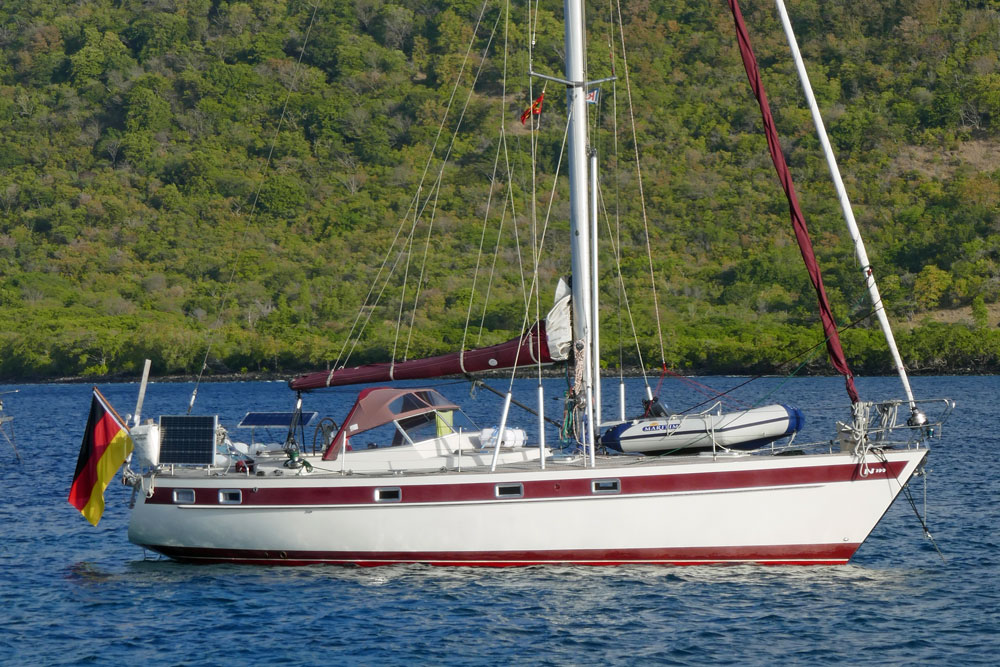
Published Specification for the Najad 390
Underwater Profile: Fin keel & skeg-hung rudder
Hull Material: GRP (Fibreglass)
Length Overall: 38'7" (11.8m)
Waterline Length: 32'10" (10.0m)
Beam: 11'6" (3.5m)
Draft: 6'1" (1.9m)
Rig Type: Masthead sloop
Displacement: 20,944lb (9,500kg)
Designer: Thorwald Karlsson
Builder: Najad Varvet AB (Sweden)
Year First Built: 1984
Year Last Built: 1995
Published Design Ratios for the Najad 390
1. Sail Area/Displacement Ratio: 17.1
2. Ballast/Displacement Ratio: 42.1
3. Displacement/Length Ratio: 265
4. Comfort Ratio: 36.3
5. Capsize Screening Formula: 1.7 .
Performance Predictions, Based on the Design Ratios
The Najad 390 has a moderate displacement of 20,944 lb (9,500 kg), a sail area of 807 sq ft (75 sq m), and a ballast ratio of 42.1%. These numbers indicate that the boat is stable, stiff, and reasonably fast.
The sail area/displacement ratio of 17.1 suggests that the boat can reach its maximum hull speed of 7.7 knots in favorable conditions, and satisfy the sailing performance expectations of most cruising sailors.
The ballast/displacement ratio of 42.1 means that the boat can stand up well to its canvas in a blow, and power through the waves.
The displacement/length ratio of 265 tells us that the boat is a moderate displacement cruiser, which means it can carry all the cruising gear without compromising its performance.
Most of today's sailboats intended for offshore cruising fall into this displacement category. The comfort ratio of 36.3 suggests that the boat has a comfortable motion at sea, similar to what you would expect from a moderate bluewater cruising boat.
The capsize screening formula of 1.7 indicates that the boat has an excellent righting capability if capsized, and is well suited for ocean passages.
Alternative Versions & Options
The Najad 390 was offered in two versions: standard and shallow draft.The standard version had a draft of 6'1" (1.9 m), while the shallow draft version had a draft of 5'3" (1.6 m).
Both versions had an encapsulated long fin keel and a skeg-hung rudder. The boat was also available with different rigging options: sloop or cutter.
The sloop version had a masthead rig with a single forestay and a single backstay. The cutter version had a fractional rig with two forestays and two backstays.
The boat could also be customized with various options, such as teak decks, bow thruster, electric winches, heating system, generator, solar panels, wind generator, watermaker, radar, autopilot, and more.
Number & Location of Sleeping Berths
The Najad 390 has two sleeping cabins with double berths and one head with shower. The forward cabin has a V-berth with storage lockers and shelves. The aft cabin has an island berth with drawers and hanging lockers. The head is located aft to starboard, next to the companionway. The salon has two settees that can be used as single berths, and a folding table in the center. The galley is located aft to port, opposite the head. It has a double sink, a three-burner stove with oven, a refrigerator/freezer, and ample storage space. The navigation station is located forward to port, next to the mast support.
History of the Boatbuilder
Najad Varvet AB was founded in 1971 by Berndt Arvidsson and Lars Johansson in Henån on Orust Island in Sweden. The company started by building small sailing dinghies and later expanded to larger cruising yachts. Najad became known for its high-quality craftsmanship and attention to detail, using traditional methods and materials such as mahogany and teak. Najad also collaborated with renowned designers such as Judel/Vrolijk & Co., Rhodes Young Design Ltd., Germán Frers Jr., Dick Zaal Design BV., and Eric Segerlind.
Najad built more than 2,000 boats over four decades, ranging from 28 to 57 feet in length. Some of the most popular models include the Najad 320 (1984-1992), the Najad 361 (1994-2002), the Najad 400 (1998-2004), the Najad 440 (2005-2010), and the Najad 490 (1998-2008). In 2008, Najad was acquired by Nord West Yachts AB, another Swedish boatbuilder. In 2011, Najad filed for bankruptcy and was bought by a group of investors led by Gunnar Svensson.
In 2012, Najad merged with Maxi Yachts AB, another Swedish boatbuilder, and formed Najad Yachts of Sweden AB. The company continued to produce new models, such as the Najad 355 (2012-2014), the Najad 505 (2013-2015), and the Najad 570 CC (2016-present).
Secondhand Values
The Najad 390 is a sought-after boat in the secondhand market, due to its reputation for quality, durability, and performance. The price of a used Najad 390 depends on the year, condition, equipment, and location of the boat. According to the data from YachtWorld , the average asking price of a Najad 390 in 2021 was $153,000 USD, with a range from $95,000 to $210,000 USD. The oldest boat listed was from 1985 and the newest was from 1995.
Press Reviews
The Najad 390 has received positive reviews from various sailing magazines and websites. Here are some excerpts from some of them:
- "The Najad 390 is easy to handle under power and to sail shorthanded. She has a deep forefoot, encapsulated long fin keel and rudder protected by a large skeg. This means she doesn’t pound to windward and tracks well downwind." Yachting Monthly
- "The Najad 390 is a moderate-weight masthead sloop which is a reasonably good performer. It is very stable/stiff and has an excellent righting capability if capsized and is best suited as a bluewater cruising boat. The Najad 390 will easily deliver 6 knots, and her large rudder is nicely balanced." Sailboat Cruising
- "The Najad 390 is a well-built and well-equipped cruising yacht that offers comfort and safety for long-distance sailing. The interior is spacious and cozy, with plenty of storage space and ventilation. The cockpit is large and protected, with good visibility and access to the controls. The deck layout is simple and functional, with wide side decks and sturdy handrails." Sailboat Guide
- "The Najad 390 is a classic example of Swedish craftsmanship and design. The boat is solidly constructed, with a high-quality finish and fittings. The boat is also elegant and graceful, with a sleek hull and a low-profile coachroof. The boat is a pleasure to sail, with a balanced helm and a responsive rig." Sailboat Data Sheet
Owner Testimonials
The Najad 390 has many satisfied owners who appreciate its features and performance. Here are some testimonials from some of them:
- "We have owned our Najad 390 for 10 years now and we love it. It is a comfortable and reliable boat that has taken us to many places in Europe and beyond. We have sailed in all kinds of weather and sea conditions, and the boat has always performed well. We especially like the center cockpit design, which gives us a lot of privacy and space in the aft cabin." Peter & Anne from the UK
- "We bought our Najad 390 in 2015 after looking for a long time for the perfect cruising boat. We were impressed by the quality and condition of the boat, which was built in 1992 but looked like new. The boat has everything we need for living aboard, such as a spacious galley, a large fridge/freezer, a heating system, a generator, and a watermaker. The boat also sails beautifully, with a smooth motion and good speed." Lars & Maria from Sweden
- "We have been sailing our Najad 390 for 5 years now and we are very happy with it. It is a sturdy and seaworthy boat that can handle any situation. We have sailed across the Atlantic twice with it, and it was an amazing experience. The boat is also very comfortable and cozy inside, with plenty of woodwork and natural light. The boat is easy to maintain and repair, thanks to its simple design and high-quality materials." John & Susan from USA
The above text was drafted by sailboat-cruising.com using GPT-4 (OpenAI’s large-scale language-generation model) as a research assistant to develop source material; we believe it to be accurate to the best of our knowledge.
Other sailboats in the Najad range include:
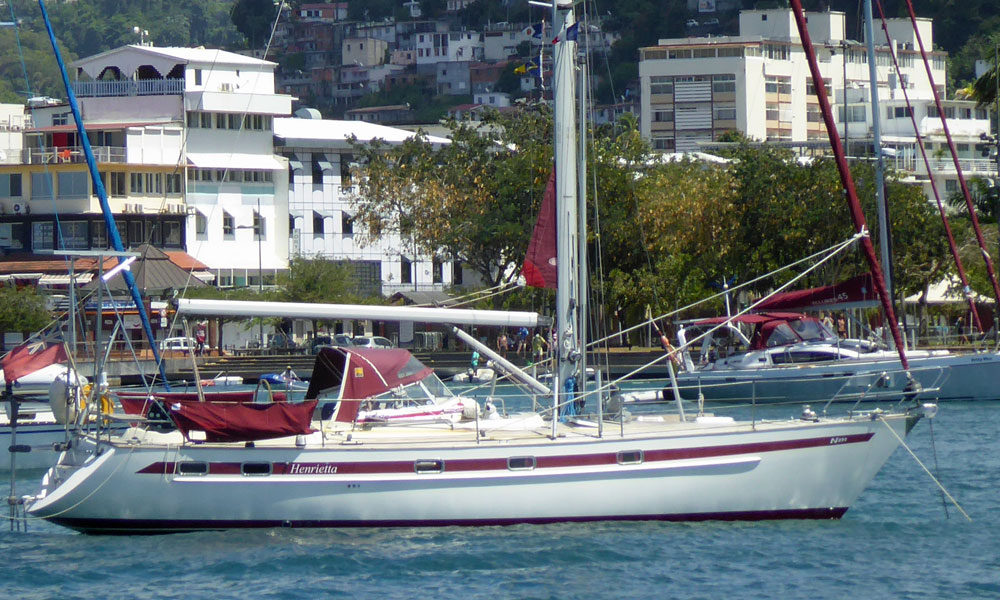
Recent Articles
Used Sailing Equipment For Sale
Feb 28, 24 05:58 AM
My Vagabond 47 Sailboat 'Untethered Soul' is for Sale
Feb 27, 24 12:40 PM
The Newport 41 Sailboat
Feb 24, 24 04:33 AM
Here's where to:
- Find Used Sailboats for Sale...
- Find Used Sailing Gear for Sale...
- List your Sailboat for Sale...
- List your Used Sailing Gear...
- Sign-up for our newsletter, 'The Sailboat Cruiser' ...
- Identify this month's Mystery Boat...
Our eBooks...

A few of our Most Popular Pages...

Copyright © 2024 Dick McClary Sailboat-Cruising.com
Review of Najad 390
Basic specs..
The boat is typically equipped with an inboard Volvo Penta MD31A diesel engine at 59.0 hp (43 kW), which gives a max speed about 7.1 knots.
The transmission is a shaft drive. A shaft drive will in the long run require less maintenence than other types of drive e.g. a sail drive.
The fuel tank which is made of stainless steel has a capacity of 250 liters (66 US gallons, 54 imperial gallons).
Sailing characteristics
This section covers widely used rules of thumb to describe the sailing characteristics. Please note that even though the calculations are correct, the interpretation of the results might not be valid for extreme boats.
What is Capsize Screening Formula (CSF)?
The capsize screening value for Najad 390 is 1.67, indicating that this boat could - if evaluated by this formula alone - be accepted to participate in ocean races.
What is Theoretical Maximum Hull Speed?
The theoretical maximal speed of a displacement boat of this length is 7.7 knots. The term "Theoretical Maximum Hull Speed" is widely used even though a boat can sail faster. The term shall be interpreted as above the theoretical speed a great additional power is necessary for a small gain in speed.
The immersion rate is defined as the weight required to sink the boat a certain level. The immersion rate for Najad 390 is about 234 kg/cm, alternatively 1313 lbs/inch. Meaning: if you load 234 kg cargo on the boat then it will sink 1 cm. Alternatively, if you load 1313 lbs cargo on the boat it will sink 1 inch.
Sailing statistics
This section is statistical comparison with similar boats of the same category. The basis of the following statistical computations is our unique database with more than 26,000 different boat types and 350,000 data points.
What is Motion Comfort Ratio (MCR)?
What is L/B (Length Beam Ratio)?
What is Displacement Length Ratio?
Maintenance
If you need to renew parts of your running rig and is not quite sure of the dimensions, you may find the estimates computed below useful.
This section shown boat owner's changes, improvements, etc. Here you might find inspiration for your boat.
Do you have changes/improvements you would like to share? Upload a photo and describe what to look for.
We are always looking for new photos. If you can contribute with photos for Najad 390 it would be a great help.
If you have any comments to the review, improvement suggestions, or the like, feel free to contact us . Criticism helps us to improve.
Great choice! Your favorites are temporarily saved for this session. Sign in to save them permanently, access them on any device, and receive relevant alerts.
- Sailboat Guide

Najad Yachts
Originally founded by Berndt Arvidsson and Thorwald Karlsson in Kungsviken on the island of Orust, Sweden. They spent a number of years fitting out boats for other builders until they commissioned the design, and created the tooling for their first boat under their own brand, the NAJAD 34.
- Eric Segerlind
- Erik Segerlind
- Judel/Vrolijk & Co.
- Olle Enderlein
- Peter Norlin
- Thorwald Karlsson
25 sailboats built by Najad Yachts

Aphrodite 380/38

Najad 520 DS

Najad 440-1

Najad 440-2 CC

- About Sailboat Guide
©2024 Sea Time Tech, LLC
This site is protected by reCAPTCHA and the Google Privacy Policy and Terms of Service apply.

NAJAD 390 similar search results:
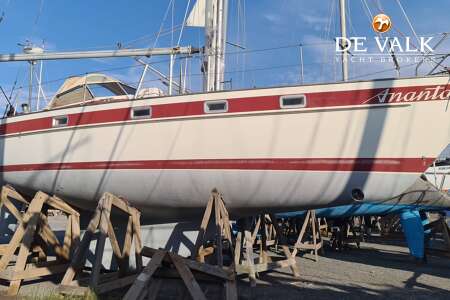
HALLBERG RASSY 382

BENETEAU 411
The najad 390 shown below has been sold:.

Sales information
- De Valk Hindeloopen The Netherlands
- +31 514 52 40 00
- Call the broker
e-mail the broker
Tell a friend.
- download brochure
Take time onboard with a live video tour
Seen a boat that piques your interest but can't make a visit in person? One of our brokers will be your eyes and ears as they take you on a video tour with their phone. You can also ask them questions about anything that isn't visually obvious. Make the call and be welcomed aboard...

Download brochure
Broker's comments.
Beautifully crafted first class Scandinavian sailing yacht, strongly build and therefore popular with long distance sailors. As Najad has been building yachts for many years, they have built up a very good reputation. With their excellent designs, craftsmanship and detailing, their whole range is very much appreciated by the demanding yachtsman.
General - NAJAD 390
GRP sailing yacht Najad 390 "Triton", built in 1995 by Najadvarvet in Henan - Sweden. Hull number: 105, design by G. Nissen. Built according to Lloyd's specifications for "Certificate of Hull Construction". Dim.: Loa 11,75 m (Lwl 10,00 m) x 3,50 m x 1,85 m, mast height above waterline: 18,50 m. The hull is of glass reinforced plastic (GRP) - white with carmine red trim line and waterline. Superstructure and deck made of sandwich construction with devinyl cell as spacing material for strength and heat isolation, teak deck. Stainless steel port holes with mosquito screens. Round bilged hull, fin keel of cast iron and completely in capsulated by GRP. The rudder is of GRP with core of 35 mm diameter stainless steel stock, strong rudder fittings of cast bronze. Fuel capacity: 250 litres (stainless steel tank), fuel level indicator. Fresh water capacity: 350 litres (stainless steel tank), fresh water indicator. Holding tank of 60 litres (stainless steel tank) with electric/manual pump. Displacement: 9,5 tonnes, ballast: 4 tonnes. Aluminium steering pedestal with stainless steel wheel - covered with leather, compass and single lever control for engine, stainless steel chain and wire transmission to a large quadrant, emergency tiller steering direct on rudder pole.
Accommodation
Classic mahogany interior, saloon and two cabins, 4 (+2) berths. Eberspächer Airtronic D5 hot air heating (June 2008). Pressurized water system, foot pump with faucet, hot water through 30 litres boiler (220V/engine). Fore cabin with two comfortable full length berths, stowage space under the berths, two drawers, spacious cupboard forward over berths. Shower compartment to port and cupboard with shelves to starboard in separate area, full standing height in the forward cabin. Spacious and light saloon with full standing height of 1,95 m, L-shaped settee on port side and straight settee on starboard side), large table, bookshelves and cabinets on both sides. Seaberth on port with lee sail and on starboar with lee shelf. L-shaped galley with large working surface covered in easily cleaned and hard wearing laminate, two stainless steel sinks, mixer tap for hot and cold pressurized water and mechanical foot pump for fresh water, three burner gas stove with oven (cardanic of 2011), well insulated ice box of 130 litres with compressor, lots of storage space. Two stainles steel gas bottles of 10 kg in locker with electric turn off switch. Large toilet room on the starboard side; headroom: 1,95m, wash basin, pump toilet with holding tank, mixertap with shower handle for hot and cold pressurized water, oil skin locker with drainage. Aft cabin; wardrobe and linen cupboard in passage way, two wide berths, stowage space under berths, cupboards above berths at aft end, table, cabinet above settee, settees on both sides forward of berths. Pionier radio with CD player; speakers in saloon and cockpit. FM/TV antenna on top of the mast.
Volvo Penta TAMD 22A - 72 hp diesel engine, revised in 2009, 897 hours after revision, indirect cooling system. Well insulated engine room with good access, mechanical gearbox. Stainless steel propeller shaft - bearing and the Volvo seal are replaced March 2011, three bladed Maxprop. Bow thruster of 6 hp. Electric circuit: 12V/220v, shore power. Alternator 110A (Jan. 2009). Mastervolt BI 1202 battery isolator (Jan. 2009). Mastervolt battery charger 110-220V // 12V/35A. (Dec. 2009). Mastervolt Alpha Pro voltage regulator. Mastervolt 12V-220V Sinus inverter 800W. (Oct. 2006). Masterlink BTM III battery monitor (Oct. 2006). Batteries: service 2x 150 Ah. (Dec. 2009) + start 1x 100 Ah. (June 2011). Honda generator 1000W/12V (June 2008). Electric and manual bilge pump. Two fire extinguishers.
Suunto compass on pedestal. Autohelm log and echo sounder. Raymarine ST60+ wind set and clause hauled function (June 2008). Autohelm multi display at chart table. Autohelm ST7000 / 2S autopilot (May) with remote control. Raymarine C120 chart plotter with GRP and radar function (Sept. 2006). Raymarine radar (60 cm) (Sept. 2006). Raytheon 300 GPS at chart table as spare. Raymarine 240E VHF m. DS70 at chart table and cockpit (Sept. 2006). Raymarine 101E VHF hand held (Sept. 2006). Icom 706 MKIIG transceiver (May 2008). Navtex Pro Plus 490 / 580 kHz (Apr. 2008).
Fixed windscreen, sprayhood, cockpit cover, sun awning, cockpit table. Quick Antares 1000W/12V electric anchor winch (June 2008). Bruce stainless steel anchor with approx. 40 m stainless steel chain, Bruce anchor of 10 kg on aft deck. Bathing platform, boarding ladder of stainless steel. Two wired stainless steel sea railing. Cockpit shower with connection in cockpit and on bathing platform. Vectra inflatable dinghy for 4 persons (Apr. 2007), Mercury 4T - 2,5 hp outboard (Apr. 2007) on bracket, Davit on radar mast for support outboard. Plastimo 4 persons life raft in container (Apr. 2007) - needs inspection. Life jackets - 4x inflatable, two safety harnesses. EPIRB Mc.Murdo Smartfind with GPS and MMSI code (May 2008). Firdell radar reflector, emergency flares, set of signal flags (May 2008), Plastimo rescue sling.
Sloop rigged, Selden aluminium double spreader mast, Selden aluminium boom (type 171 of May 2008) single line reef (3 reefs). Furlex head sail furling system - stay replaced in June 2008. Sails: Battened main sail (38m2) - maindrop with Lazy Jacks, Furling genoa (52m2). Rodkick boomvang, spi pole on mast. Isolated backstay, mechanical backstay adjuster. Top shroud and fore stay replaced June 2008. Winches: 2x Andersen 56ST winches, 1x Andersen 46 ST winch for mainsail halyard and two reefing lines. 2x Andersen 12 ST winches on mast.
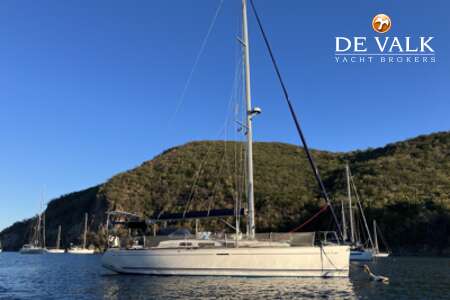
DUFOUR 40 PERFORMANCE
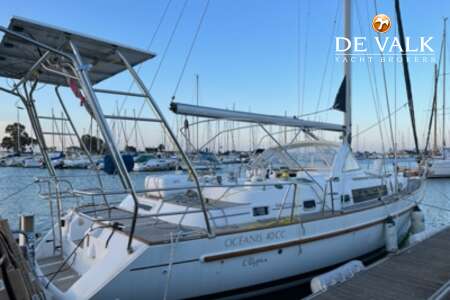
BENETEAU OCEANIS 40 CC
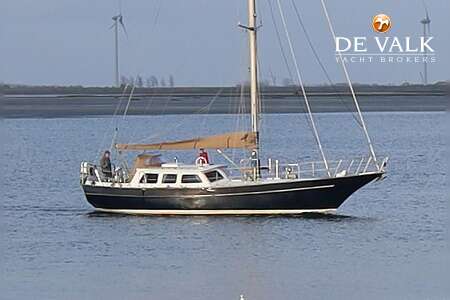
ENDURANCE 38
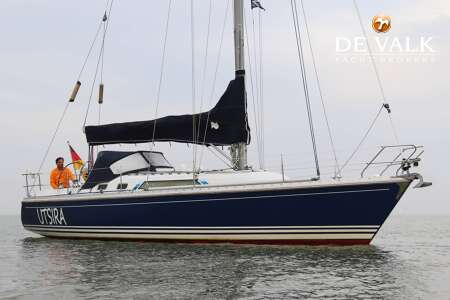
WINNER 11.20

JEANNEAU SUN ODYSSEY 36I
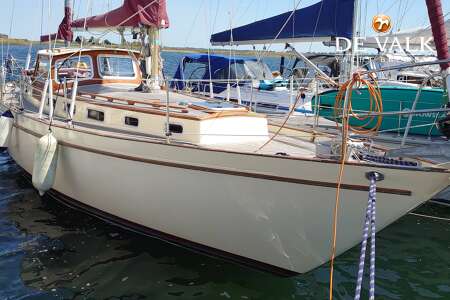
FRANS MAAS CALYPSO 43
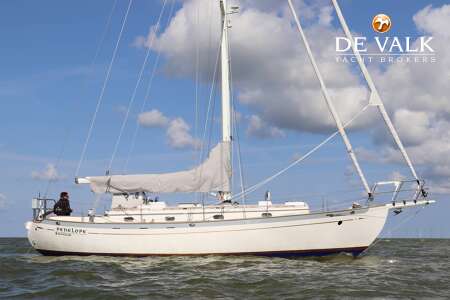
- Choose the kind of boat Big boats Motor boats Rubber boats Sailing boats Sailing multihull boats
Najad Varvet Najad 390

General Data
Shipbuilder:, see also: boats for sale.
- Jeanneau Sun Odyssey 40 DS
- Beneteau Yachts Beneteau Oceanis 381
- Feeling Kirie 396
- Dufour 385 Grand Large
Overall length:
Waterline length:, maximum beam:, displacement:, straightening:, construction materials:, sail details mq, equipments:, transmission:, interior materials:, water tank:.
Previous Models
The beginning of Najad, in 1970, Torwald Karlsson and I called Olle Enderlein who said: “Of course I will draw you a fine boat, how big should it be?” – “Around 10 meters” we said, and he made an outline proposal that we extended, expanded and changed. After all, one wants to have as much volume as possible in a boat, a little too much sometimes. In the end, we settled upon a design that was 10.30m long and 3.10m wide.
The smallest Najad boat was the Najad 320. She is 32 feet in length but as spacious as most 34 footers. She is a genuine Najad throughout. From the long keel giving the best smooth sailing characteristics to the safe and beautiful teak laid decks and the rich satin-finished mahogany down below. The Najad 320 has been designed for extended cruising.
The Najad 320 will help you fulfil your happiest dreams.
The basic difference relating to the interior of a Najad compared to other yachts is the well designed and proven layout. Considerable attention to detail and finish of the woodwork is paid. A yacht which you are going to use as your home and that will work well and suit your requirements must allow you the choice of customization. This requires a good basic layout.
The berths must be both comfortable and in pleasing surroundings. Would you like a cosy atmosphere in which to welcome friends? The Najad 330 fulfils this requirement.
In the Najad 331 Najad have created a yacht with excellent sailing performance without compromising any of the traditional Najad qualities. The Najad 331 is not only impressive to sail, it has a well-designed layout, featuring two large cabins, in the bow and aft, enabling four people to live comfortable on board. The outstanding precision and high quality of finish is typical of the Najad yard which has 25 years of knowledge and experience.
On the outside the Najad 332 features the new style with the thin side stripe and double waterlines, giving the impression of a lower freeboard, accentuating her shear lines and giving prominence to her raised bow, with fine entry. Despite the potential constraints of her LOA, the 332’s cockpit is provisioned to accept wheel or tiller steering equally well, this space benefits from excellent weather protection from the stylish windshield on top of the coach roof, being a signature feature of Najad.
Najad 340 is built for long and pleasant stays both in port and at sea. The stable and modern hull with its elegant lines makes the Najad 340 excellent in light winds and provides it with incredible safety even in bad weather.
The area below deck is spacious and gives maximum comfort. Hand polished mahogany and outstanding craftsmanship gives the Najad a classic good look and provides it with high quality.
The Najad 343 is just as safe and secure to sail in the open sea as she is to handle among jetties, boats and skerries. At sea it’s her long keel that gives her calm and gentle manners. In port it’s her separate skeg and rudder that make her simple and handy to turn and manoeuvre.
Welcome below deck! Step down the broad companionway into a spacious and airy saloon that you’d only expect to find on much larger boats.
Note the first-class workmanship as you inspect the fittings. Enjoy the rounded, smooth surfaces that have been formed by skilled hands. Let your eyes rest on the satin-smooth finish of the dark-red mahogany woodwork. Try out the sofa seat cushions covered in beautiful, hardwearing plush.
This is a home to be proud of.
The Najad 355 – Sailing performance beyond what you might expect from a safe and comfortable cruising yacht. Some facts: The strong well-dimensioned hull is designed to offer first-class sailing without encroaching on interior space or Najad’s state of the art safety.
Thoughtful use of space and excellent facilities are two things that characterise Najad 360.
In every detail, you feel the expertise behind this craftsmanship and there’s no coincidence that Najad 360 is one of the most popular in its class.
We have improved the sailing performance of the Najad 361 without compromising the comfort and safety for long-distance cruise. The yacht now has a greater waterline together with a longer overhang at the stern, the top and lower shrouds are moved inboard narrowing the sheeting angel enabling the yacht to sail closer to the wind. The Najad 361 has a completely new underwater configuration.
Now fitted with a bolt-on lead keel and a semi-balanced rudder designed with NACA wing sections thus ensuring that there is an optimum water passage passing the hull and improving the efficiency of the steering. A small wing at the bottom of the keel reduces the water flow beneath the keel which result in less drag.
With a Najad 370 you can fulfil your longing for freedom and dreams of long-distance cruising becomes a reality. The Najad 370 is the yacht that has been designed after many miles of experience and allowa considerable possibilities for the purchaser to incorporate a personal touch. The Najad 370 is a true long-distance cruiser from Najad- varvet on Orust in Sweden.
Najad 371 is designed for long cruises and long periods at sea, and of course to go just over the day.
That ́s why she has three superb cabins with space enough to move dress and store personal claims, and with doors to close when privacy is sought in the mist of company.
The Najad 373 is a very desirable yacht, good enough to excite the jaded palate of the most experienced boat tester. She will turn heads wherever she sails, and cries out for an owner who will put her to hard use, whether it be local cruising or crossing oceans, and is able to spend time cherishing her fine finish and practical design.
Despite the fact that she is much better performer than past Najads, she is not the quickest boat afloat – which just means you spend more time at sea enjoying her good points: comfortable sea berths, secure galley, soft ride and light steering, among others.
Traditional values contemporary performance.
One of our most successful yacht designs ever – the Najad 380 is not only a well proportioned and beautiful looking yacht, but offers true ocean-going performance.
Built using vacuum infusion, for a strong and ‘stiff’ hull, while two large double-berth cabins, a spacious saloon and fully equipped linear galley make life onboard extremely comfortable.
N380 Aphrodite
For many years, cruiser design has taken its inspiration from racing. This caused us to think ”Why not take a completely different tack?”
That is, build new yachts that evoke the aesthetic of yesteryear but that take full advantage of modern-day technology.
Which is exactly what we did. We created a completely new range of Aphrodite yachts, for people who appreciate classic beauty and are looking for something out of the ordinary.
Najad 390 is a boat for long trips and long periods at sea and in port. She is fast and stiff, and has a cockpit that provides protection and security even when the weather is against. She has room for many guests, but is still easy to handle and take care when you’re only two. She is built for the open seas, with a long keel safe, yet manoeuvrable enough for the solitary nature of the port still be accessible.
She has a large flat deck with non-slip teak. Below deck, she is a warm and exclusive residence for people who want to live and stay with comfort and convenience, even at sea.
We pay a lot of attention to the interior layout of our yachts because we feel that it must be practical at sea as well as comfortable in the harbour. To achieve this, Najad have utilised the space to provide ample storage and a safe working environment which well suit both long-distance and weekend sailors.
The style and finish of the mahogany interior is very special and gives the boat a natural feeling of quality.
The new N400 model will offer a generous aft cabin and full standing height in the walkway aft as well as in the galley. It will also give the possibility of double aft cabins as well as for a second heads compartment with shower in the forepeak. Depending on each owner’s preferences the yacht interior is semi-customised between all options offered.
Mid-range cruising style.
Inheriting the same Najad family genes from more recent new launches, the new Najad 405 is a natural development of the outgoing N400. The rig is taller, in line with the overall enhanced performance and sportier characteristics now set in space across all of Najad ́s newest model range. The balanced spade rudder will have no skeq and offer a light feeling to the helm, making for easier tacking and less stressful close quarter manoeuvres.
At Najad, when we create a new yacht, we don’t take shortcuts. The new Najad 410 has been developed in several steps over a few years, as she evolved into the yacht we are presenting on the following pages.
The Najad 410 is based on our experiences from some of Najad’s most successful recent models. Her predecessor, the Najad 405, was a success when she broke the Scandinavian traditionalism with her fast-sailing, manoeuvrable hull developed by judel/vrolijk & co and her light, modern interior, designed by Rhoades Young Designs.
The Najad 411 is iconic to Najad . With its modern yet well-composed lines, she stands out in the Najad family. With a spacious amidships cockpit, well-adapted rounded windscreen and an overall larger appearance profile than some of our other boats, the Najad 411 has exactly the same qualities in terms of comfort, safety and performance that customers can expect from all Najad boats Elongated flush-mounted windows along the side reinforce the long, elegant appearance and, with its well-balanced hull and excellent sailing qualities, we believe that the Najad 411’s performance is every bit as good as her looks.
Inside, the layout is spacious with good-sized double cabins fore and aft and a longitudinal galley with plenty of room for cooking. The tables and saloon are easily accessible.
The Najad 411 is not only a beauty queen, she is also a very capable cruiser for the modern sailor.
If your desire is to cruise anywhere and to use a yacht as your home the Najad 420 is the ultimate choice. She is safe and comfortable with a good sailing performance.
These are the conclusions of more than 1000 yachtsmen who are now Najad owners. Najad 420 is a true long-distance cruiser from the Najad- varvet on Orust in Sweden.
Najad 440 is a fast cruiser for sailors with high standard and high conditions in comfort both at sea and in harbour.
The hull is slim, and this makes her fast even in low wind conditions. At the same time, this is a boat for everyone, from a small crew to a big family.
Sharing the same hull and underwater appendages as her Centre Cockpit sister, the Najad 440 Aft-Cockpit is a very attractive looking yacht and is generally regarded as the more ‘sporty’ version of the two. For an enthusiastic crew, the most visually striking aspect is likely to be the large ‘Mediterranean-style’ cockpit with twin helm stations. With this much space available, the cockpit is also a very sociable place to entertain family and friends when either underway or when lying to anchor in a quiet bay.
The contemporary hull shape offers fine performance matched with unrivalled comfort and space. The epitome of a Najad.
One of the immediately striking characteristics of the Najad 441 is the large, flush teak deck, which gives the yacht its classic lines and also makes it easy and safe to work on the yacht. The cockpit is spacious and is protected by a fixed, toughened glass windscreen which is further enhanced by sprayhood that folds flat when not in use.
The hull has been completely redesigned and the addition of the NACA winged keel and a semi-balanced rudder provides enchanted sailing performance.
Th e Najad 460 is available with an amidships cockpit and is therefore the ultimate cruiser. The 460 is undoubtedly a stylish and powerful world cruiser in every respect. The cockpit is superbly protected thanks to the windscreen made from tempered glass set in stainless steel frames.
With slightly more interior volume than the 440 CC there are different options available to allow you, as the owner, to specify the ideal yacht for your needs.
There are several interior design options available for the Najad 460. One option provides up to 6 berths, consisting of a large owners’ cabin at the aft and a further two cabins in the forepart of the boat: one double and one with bunks. The fore and aft cabins have separate toilet and shower areas.
N460 Aphrodite
The legacy from the legendary yachts built on the Swedish island of Orust is plain to see. The hull’s soft sweeping forms are a pleasure to the eye. A deck of teak is just as obvious a choice as a super-structure of mahogany. Old-fashioned fresh air vents and a wooden steering wheel are details that make for an attractive overall look. A solid construction in every respect ensures a smooth and stable passage through the water. Rig and hardware are first rate.
Designing a sailing yacht, capable of sailing all over the world and at the same time being comfortable and safe for the crew, requires a great experience of long distance cruising yachts. The result is the Najad 490. A 49 foot sailing yacht with a powerful, extremely seaworthy hull of modern design.
According to the ancient Greek mythology, a Najad was a divine female creature that seduced men and women into the water. Today Najads still ensnare the hearts of sailors.
“A perfect fast ocean cruiser, with a light feeling on the helm, beautiful outside, fantastic inside: how can you not fall in love with her?” ( Yachting World ).
As you can see, times change, but some things stay the same.
N511 Aphrodite
Down in the cabin you’ll find qu ality craftsmanship, executed with extreme attention to detail. A classically designed mahogany interior. Cosy but light, with unsurpassed comfort. Lighting fittings and hardware of brass have just the right feel. Dimensions are generous and the layout is particularly well considered. It’s a place where you’ll be happy to spend time.
Aphrodite are yachts for a small and exclusive set of sailors, a select group of boat lovers who value tradition and history.
Designing a sailing yacht, capable of sailing all over the world and at the same time being comfortable and safe for the crew, requires a great experience of long-distance cruising yachts.
The result is Najad 520. A 52 foot sailing yacht with a powerful, extremely seaworthy hull of modern design and with an IMS rating of 611.
N520 Deck Saloon
The size and the volume on the Najad 520 allow a very flexible resolution. To increase flexibility and to get more out of the interior of the hull, we created Najad 520 Deck Saloon.
The Najad 380 is a 37.89ft fractional sloop designed by Judel/Vrolijk and built in fiberglass by Najad Yachts (SWE) since 2007.
The Najad 380 is a moderate weight sailboat which is slightly under powered. It is reasonably stable / stiff and has an excellent righting capability if capsized. It is best suited as a bluewater cruising boat. The fuel capacity is average. There is a good water supply range.
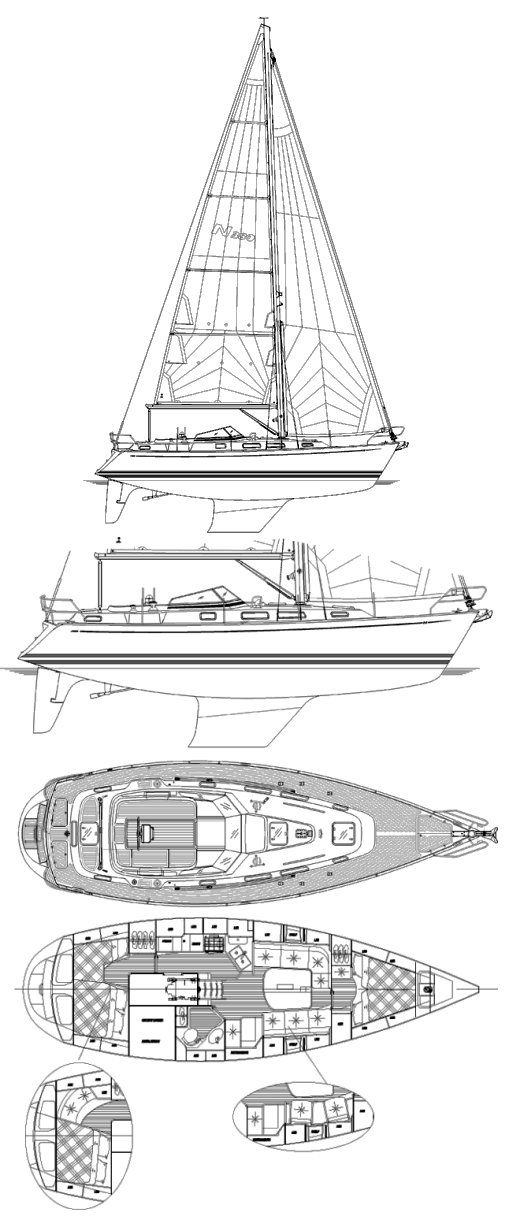
Najad 380 for sale elsewhere on the web:

Main features
Login or register to personnalize this screen.
You will be able to pin external links of your choice.

See how Sailboatlab works in video

We help you build your own hydraulic steering system - Lecomble & Schmitt
Accommodations
Builder data, modal title.
The content of your modal.
Personalize your sailboat data sheet

Moscow Muled
How to clean and care for copper mugs: the definitive guide.
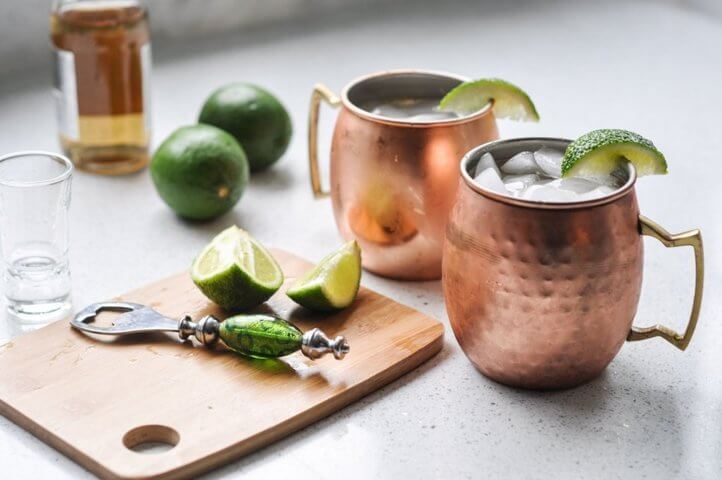
Oct 15, 2019
In this post, we reveal the complete guide to cleaning and caring for your copper mugs. From how to maximize the lifespan of your mugs to how to ensure that they maintain that brilliant copper shine, we have you covered. Let's get started!
Introduction
Since the creation of the Moscow Mule in the 1940's, copper mugs have never been more popular than they are today. This refreshing cocktail made of lime juice, vodka, and ginger beer is traditionally served over ice in an iconic copper mule mug. No matter what beverage you choose to serve in it, the appeal of the copper mug is hard to deny. As bars, restaurants and at-home use of copper mugs continues to grow in popularity, it is important to know how to properly care for and clean copper. This article will tell you everything you need to know, including:
Why is Cleaning Copper Mugs Important?
Why does copper tarnish.
- How Do you Clean Copper Mugs?
- 5 Easy & Natural Ways to Remove Copper Tarnish
- Is it Safe to Drink from Copper Mugs?
Are Copper Mugs Dishwasher Safe?
- Lined Versus Unlined Copper Mugs
- The Benefits of Using Copper Mugs
- Essential Tips to Care for your Copper Mugs

Like any drinking vessel, copper cups, mugs, water bottles and tumblers need to be washed after every use. Copper does require specific care and maintenance, however it's quite simple and easy to learn and do.
First and foremost, copper mugs should be cleaned properly for health and safety reasons. Whether at a restaurant or at home, you don't want anyone getting sick from drinking from an unwashed cup.
There is something compelling about the warm glow of polished copper. A huge part of the appeal and popularity of cocktails like the Moscow Mule is the unique aesthetic of the copper mug. This metal will tarnish naturally with time and use, so cleaning it properly can be essential to keeping it shiny, and fully experiencing the many benefits of drinking from a copper mug.

Like iron developing rust, copper will naturally tarnish over time with exposure to humidity and other elements found in the air. Copper's blue-green tarnish, known as patina, can be either useful or annoying, depending on its intended use.
The patina actually serves as a protective layer for the copper beneath, and can be useful in outdoor applications such as roofing or pipes. However, when it comes to mugs or cups, we want the copper to shine as warmly as possible, so it is essential to know about preventative care and maintenance.
Don't worry, it's super easy to do, and incredibly satisfying to restore and polish your tarnished copper mugs.
How Do You Clean Copper Mugs?
Cleaning copper mugs is like cleaning most anything, except that it MUST be washed by hand. In other words, never put them in the dishwasher, ever. Take 30 seconds to gently wash them by hand with a soft sponge, soap and warm water.
For most people at home, this shouldn't be a problem. But some high-volume bars or restaurants might not be able to dedicate the time needed for proper care. This is one reason a business may prefer a tin-lined or lacquered copper cup that may need less polishing, although they too should still be washed by hand.
The most important part of cleaning your copper mug is drying it!
Residual water in the slightest amount can lead to tarnishing, so experts highly recommend you dry your copper mug twice, with two different soft towels or cloths until all moisture is removed. This extra step only takes a few moments, and will go a long way towards the durability and cleanliness of your copper mule mugs.
If you want your copper mug to look nice, dry it twice!
5 Easy and Natural Ways to Remove Copper Tarnish
Owning a copper mug comes with the added responsibility of some occasional, simple maintenance. When your favorite mug starts to turn green, here are some easy solutions to restore its natural shine!
Lemon or Limes and Salt

This simple method is quick and easy, and ideal for bars or restaurants that may have an abundance of lemons on hand. Simply pour some table or sea salt onto a dish, and cut a fresh lemon or lime into 1/4th slices. Dip the fruit slice into the salt, and scrub the copper mug with slow, methodical circles inside and out. The change should be almost instantaneous, and when the tarnish has been removed, wash under warm or cool water, and dry thoroughly.
Vinegar and Salt
Mix one cup of vinegar, one tablespoon of salt, and five cups of water. Pour the solution into a saucepan, place your mug into the saucepan, and bring it to a boil. After a few minutes, the tarnish will have disappeared, and you can remove the mug with tongs, rinse it in cold water, and dry thoroughly with two soft dish towels.
Vinegar and Baking Soda
Create a paste with three parts baking soda, and one part vinegar. Use a sponge to apply it to the mug with small circular motions and let it sit for about 10 minutes in order for the magic to happen. After that, simply rinse and dry until all moisture has been removed.
Harness the power of tomatoes to clean your tarnished copper mug! Apply the ketchup using a soft sponge or toothbrush, always rubbing in small circles. Then let it stand for 30 minutes. Remove the ketchup in the same way you applied it (a specially designated tarnish-toothbrush can be a highly effective tool for getting into those hard to reach places). Finally, rinse with water, and dry thoroughly with two soft towels.
Tamarind Paste
Tamarind is a tropical fruit, popular in Caribbean, African and Indian cuisine. It contains tartaric acid, which helps remove tarnish from brass and copper. If this is something you have access to, simply add water to create a paste, and rub it onto the copper with a soft sponge or cloth. After a few minutes, rinse off the paste, and dry completely.
Metal Polish
Although the natural methods listed above are all equally effective, inexpensive and safe, another option is to use a tarnish remover or metal polish. Popular brands like Brasso are great for polishing many different kinds of metals, but the main ingredients may be less than desirable (rubbing alcohol, ammonia, mineral spirits and silica powder). Chances are you can easily find most of the ingredients for cleaning copper mugs in your pantry, and can avoid buying a product full of harsh chemicals.
Is It Safe To Drink From Copper Mugs?
Yes, it is safe to drink from copper mugs , despite click-bait headlines, myths and legislation that may suggest otherwise. True, when using 100% pure copper mugs it is possible that trace amounts of copper could be ingested. However, this can be mitigated by using stainless-steel plated copper mugs.
Copper is an essential part of human biology, and is necessary for regulating metabolic systems and vital organs. Copper deficiency can lead to arthritis, osteoporosis, cardiovascular diseases and colon cancer.
Not only do our bodies need copper, we also have systems in place to naturally deal with any excess copper. Verified scientific studies have shown copper can do impressive things.
- Copper and Iron work together to form red blood cells.
- Copper helps maintain collagen, and along with other antioxidants, can reduce signs of aging.
- Copper helps absorb excess iron in the liver.
- Copper improves brain and nerve cell synaptic responses.
- Copper aids in digestion and helps with ulcers and inflammation.
Copper toxicity is quite rare and, according to the World Health Organization , "There is a greater risk of health effects from a deficiency of copper intake than excessive copper intake."
The FDA guidelines do not recommend using copper for any food or beverage purposes, solely because of the extra care needed to maintain it, and applies exclusively to commercial operations, with varying local and state regulations.
This is meant to protect consumers from improperly cleaned or exposed copper mugs and cookware in bars and restaurants, and does not apply to home use. The FDA suggests the public learn about proper care and maintenance before using copper mugs, but scientists have debunked the claim that a Moscow Mule can give you copper poisoning.
When using 100% pure copper mugs and a liquid with a pH below 6.0 (like lime juice), and that liquid remains in the mug for an extended period of time, there is a chance you could consume amounts of copper. This is the reason why it is generally a good idea to use copper mugs lined with stainless-steel .
No, never! All copper cookware, utensils or mugs should be washed by hand, no exceptions. Dishwashers typically use harsh detergent, powerful water sprays and high heat that can seriously harm your copper mug both inside and out.
Dishwashers can lead to dents, tarnishing, and flaking or cracking. So take 30 seconds to do right by your copper mugs, and wash and dry them by hand!
Lines Versus Unlined Copper Mugs
When purchasing a copper mug, there are three basic options - 100% copper, tin-lined, and copper plated.
Copper is a great thermal conductor, and will keep your drink colder for longer (or hotter for longer, depending on the drinks). This is a big part of what makes the Moscow Mule an attractive summer beverage, and why copper mugs are great for cocktails in general.
Lined copper mugs (usually with zinc, stainless-steel or tin) can be a great choice. The double lining improves their durability, and can give them a great look. Unlike pure copper, lined copper mugs also offer additional health benefits by avoiding reactions between acids in your drink and pure copper.
Both lined and unlined copper mugs must be washed by hand and both will develop a patina over time. Lined mugs might take slightly less time to polish, because you only need worry about the outside. However, now that you know how to clean tarnished copper mugs, it's nothing you can't handle.
Essential Tips To Care For Your Copper Mugs
Copper mugs are stylish and good for your health. They keep your cold drinks chilled, and your hot drinks steaming. Copper mugs have been used for thousands of years for water purification and health benefits, and have made a triumphant rise in popularity since the invention of the Moscow Mule in the 1940's.
Whatever you choose to put in your copper mug, remember these three simple tips:
- When serving drinks, don't let them sit for more than 4 hours. Drink up!
- After each use, take the time to hand-wash your copper mugs with soap and water, and use TWO TOWELS to dry them thoroughly.
- When your copper mug begins to tarnish, use one of the five easy and natural ways listed above to polish it to perfection.
Thank you for taking the time to become an expert on using, cleaning and caring for copper mugs. Cheers!
Did You Enjoy This Article?
Thank you for reading! If you enjoyed this article, you might also like the following articles: Why You Should Only Use Moscow Mule Copper Mugs With Stainless Steel Lining and Which Moscow Mule Copper Mugs Are Best?
Relevant Products
Moscow Mule Copper Mug
Leave a comment
Subscribe to our newsletter.
Receive exclusive deals and our latest blog posts straight to your inbox!

Shikoku Mule (Yuzu Moscow Mule)
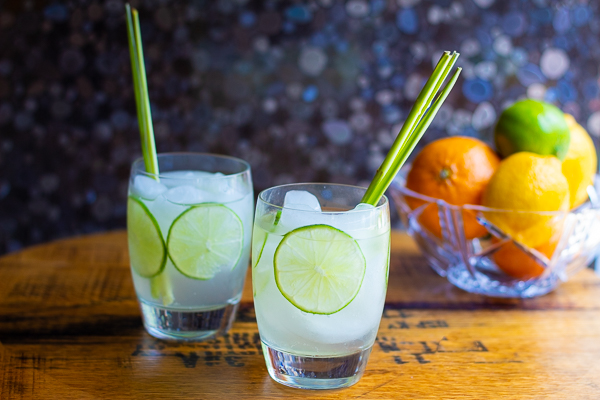
This Shikoku Mule is a creation based on the popular Moscow Mule cocktail. It’s technically a Yuzu Moscow Mule but I also used Japanese shochu instead of vodka to make this new refreshing cocktail drink.
While I used Japanese ingredients to make this recipe, I didn’t simply want to name this “Japan Mule” (which just sounds odd) or something meaningless like “Tokyo Mule” just because that’s the city in Japan that everyone knows. I named this Shikoku Mule because Shikoku in Japan is where yuzu is predominately produced.
What is yuzu?
Yuzu is a citrus fruit that can be explained as “not quite a lemon, not quite a tangerine” but the flavor of it has been described as “a cross between a grapefruit and a lime.” It’s very fragrant and has an elegant tart flavor that yuzu can be found in many cooking ingredients as well as in beauty and bath products.
Where in Japan is Shikoku?
Shikoku is smallest of the four major islands of Japan. The name directly translates as “four countries” and true to its name, the island is made up of four prefectures. Just so that you have a better idea of where Shikoku is, here is the map:

Shikoku, incidentally, is also a Japanese breed of dogs , a lesser known cousin to Akita or Shiba Inu . That’s not why I named this drink Shikoku although, now that I’m thinking about it, I also made a Salty Shiba cocktail drink recently. Hmm…I see a trend. But there’s nothing wrong with combining my two favorite things: dogs and cocktails!
What is Shochu?
Shochu (pronounced show-chew ) that I used as the base alcohol for this cocktail, is a Japanese alcoholic beverage distilled typically from sweet potatoes, barley, buckwheat, brown sugar or rice. Shochu works great for this recipe since, unlike vodka, it doesn’t overpower the flavors of other ingredients in the drink. So that you can enjoy the natural, vibrant flavors of yuzu and ginger beer.
Related article: Lean all the basics about Japanese shochu
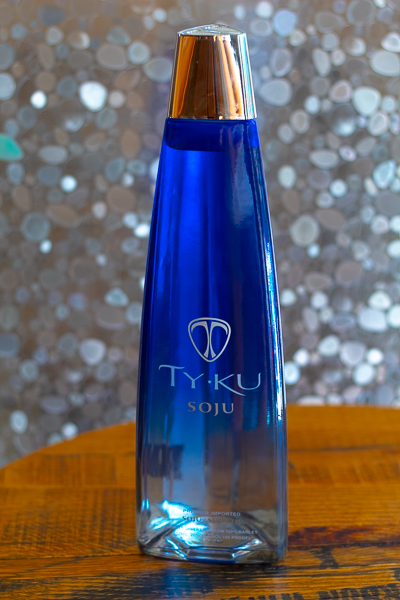
Ginger beer
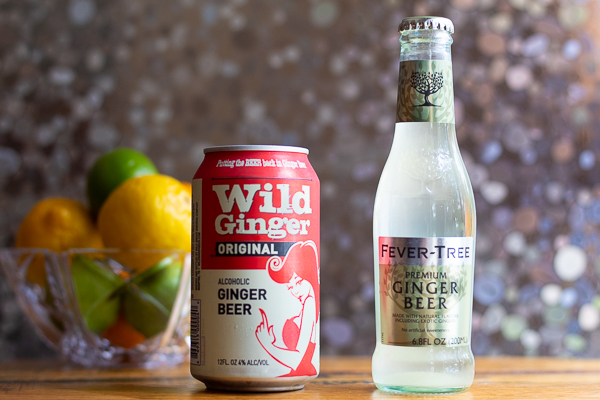
So, what exactly is ginger beer? It’s a carbonated drink, with spicy ginger flavor, that is usually non-alcoholic.
Since also I found alcoholic ginger beer, I made them two different ways – one using alcoholic ginger beer Wild Ginger and another one using the non-alcoholic version, Fever-Tree Premium Ginger Beer. They are equally refreshing. The alcoholic version just has a little more boost.

Shikoku Mule (Yuzu Moscow Mule) Recipe
Ingredients:
- 1 oz yuzu juice or yuzu syrup
- 1 oz shochu
- 4 oz ginger beer
Glass: Copper mule mug or old-fashioned
Garnish : One or a combination of:
- Lemon wedge
Instructions :
- Fill a glass with ice cubes.
- Add shochu and yuzu juice.
- Fill the glass to the top with ginger beer.
- Gently mix, garnish and serve.
Pin it for later!

Related Posts

Melon Soda Cocktail
If you visit Japan, there is no question Japan is in love with the fruity…

Salty Shiba (Shiba Dog) Cocktail Recipe
Not every dog owner can say that they have a cocktail drink named after the…
Jane | 27th Aug 19
As I was reading your post, I was salivating. LOL. I love this kind of drink because it has citrus in it. And I love anything with citrus, lime..
I will copy your recipe for when we have a gathering.
admin | 28th Aug 19
Citrus does have that effect on your taste buds! lol I love anything with citrus, too. Let me know how it turns out, Jane! Thanks!
Leave A Comment
Cancel reply.
Your email address will not be published. Required fields are marked *

IMAGES
VIDEO
COMMENTS
NAJAD 390 is a spacious and comfortable cruising sailboat, designed by Judel/Vrolijk and built by Najadvarvet in Sweden. It features a center cockpit, a large aft cabin, a well-equipped galley and a high-quality interior. Compare it with the NAJAD 380 and other models at sailboatdata.com.
The Board of Directors of Arcona Najad Yachts AB then split the two brands into separate companies in 2022. Najad AB. Odelbergs väg 2, 134 40 Gustavsberg, Sweden. [email protected]. +46 (0)304 30 800. Years in Business: 1967 - present.
One week it must be blue with two loos, the next red with a fin and skeg. It's a battle between heart and head and even more complicated as a couple. Miranda's priorities were a good sailing pedigree and classic look and feel. The Najad 390 will easily deliver 6 knots, and her large rudder is nicely balanced.
Najad 390 is a 38′ 6″ / 11.8 m monohull sailboat designed by Eric Segerlind and built by Najad Yachts between 1984 and 1995. Great choice! Your favorites are temporarily saved for this session. ... sailboatdata.com / CC BY. Embed Embed. View Demo.
The Najad 390 is a 38.55ft masthead sloop designed by Eric Segerlind and built in fiberglass by Najad Yachts (SWE) between 1984 and 1995. It accomodates 6 people in 2 cabins plus salon. The Najad 390 is a moderate weight sailboat which is a reasonably good performer. It is very stable / stiff and has an excellent righting capability if capsized.
The price of a used Najad 390 depends on the year, condition, equipment, and location of the boat. According to the data from YachtWorld, the average asking price of a Najad 390 in 2021 was $153,000 USD, with a range from $95,000 to $210,000 USD. The oldest boat listed was from 1985 and the newest was from 1995.
najad 390 Archives - sailboatdata. New Topic. all categories. ×. najad 390. Categories. Oh, bother! No topics were found here. You must be logged in to create new topics.
The DL-ratio for Najad 390 is 264 which categorizes this boat among 'light crusers & offshore racers'. Heavy Light 46% 0 50 100. 46% of all similar sailboat designs are categorized as heavier. A heavy displacement combined with smaller water plane area has lower acceleration and is more comfortable.
Source: sailboatdata.com / CC BY. Suggest Improvements 25 sailboats built by Najad Yachts. Sailboat. Najad 320. ... Najad 390. 1984 • 38 ...
GRP sailing yacht Najad 390 "Triton", built in 1995 by Najadvarvet in Henan - Sweden. Hull number: 105, design by G. Nissen. Built according to Lloyd's specifications for "Certificate of Hull Construction". Dim.: Loa 11,75 m (Lwl 10,00 m) x 3,50 m x 1,85 m, mast height above waterline: 18,50 m.
1992 Najad 390. US$129,000. BVI Yacht Sales LTD | martinique, Martinique. Request Info. <. 1. >. * Price displayed is based on today's currency conversion rate of the listed sales price. Boats Group does not guarantee the accuracy of conversion rates and rates may differ than those provided by financial institutions at the time of transaction.
Find Najad Najad 390 sailboats for sale in your area & across the world on YachtWorld. Offering the best selection of Najad boats to choose from. YachtWorld. Boats for sale. Sail. Najad. najad 390. Najad Najad 390 Sailboats for sale. FILTERS. Save Search. Sail Najad Najad: Najad 390 Clear All. Condition. All. New. Used. Length. Year. Price. 1 ...
The Najad 391 is a 39.7ft masthead sloop built in fiberglass by Najad Yachts (SWE) between 1995 and 2003. ... The data on this page has been derived from different sources but a significant part is attributed to sailboatdata.com. We thank them for their encouragements and friendly collaboration.
Najad Varvet; Model: Najad 390; See also: boats for sale. Jeanneau Sun Odyssey 40 DS Beneteau Yachts Beneteau Oceanis 381 Feeling Kirie 396 Hunter 380 Najad Varvet Najad 361 Boat Files General Data. Overall length: 11.75 m; Waterline length: 10 m; Maximum beam: 3.5 m; Draught: 1.85 m; Displacement: 9500 kg; Ballast: 4000 kg;
Najad 340 is built for long and pleasant stays both in port and at sea. The stable and modern hull with its elegant lines makes the Najad 340 excellent in light winds and provides it with incredible safety even in bad weather. ... Najad 390 is a boat for long trips and long periods at sea and in port. She is fast and stiff, and has a cockpit ...
Optional shallow draft: 1.8m / 5.9 ft17.25 The N400 was updated and became the N405 between 2006 - 2009. Same hull. Update includes: A taller rig. Mast above DWL: 18.5 m / 60.7 ft Deeper draft: 2.1m / 6.89 ft Shallow draft option: 1.9m / 6.23 ft
Najad boats for sale on YachtWorld are listed for a swath of prices from $45,347 on the more modest side, with costs up to $654,971 for the most luxurious yachts. What Najad model is the best? Some of the best-known Najad models presently listed include: 373, 390, 460, 490 and 34.
1 oz. fresh lime juice. 0.5 0z. maple syrup. 1 tsp ginger beer. 4 dashes apple bitters. Instructions: Put crushed ice in a mug, then add the rye whiskey, lime, haskap liqueur, and maple syrup. Top with ginger beer. Add bitters. Garnish with ginger and serve.
The Najad 380 is a 37.89ft fractional sloop designed by Judel/Vrolijk and built in fiberglass by Najad Yachts (SWE) since 2007. The Najad 380 is a moderate weight sailboat which is slightly under powered. It is reasonably stable / stiff and has an excellent righting capability if capsized. It is best suited as a bluewater cruising boat.
Vinegar and Baking Soda. Create a paste with three parts baking soda, and one part vinegar. Use a sponge to apply it to the mug with small circular motions and let it sit for about 10 minutes in order for the magic to happen. After that, simply rinse and dry until all moisture has been removed.
This Shikoku Mule is a creation based on the popular Moscow Mule cocktail. It's technically a Yuzu Moscow Mule but I also used Japanese shochu instead of vodka to make this new refreshing cocktail drink. While I used Japanese ingredients to make this recipe, I didn't simply want to name this "Japan Mule" (which just sounds odd) or ...
Rabochaya ulitsa, 35А, Elektrostal, Moscow Region, 144001. Coordinates:. 55.775454, 38.472688
LENGTH: Traditionally, LOA (length over all) equaled hull length. Today, many builders use LOA to include rail overhangs, bowsprits, etc. and LOD (length on deck) for hull length. That said, LOA may still mean LOD if the builder is being honest and using accepted industry standards developed by groups like the ABYC (American Boat and Yacht Council).